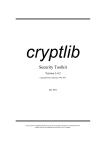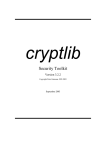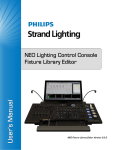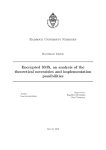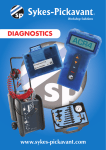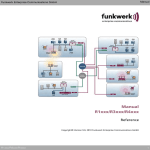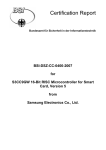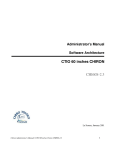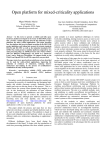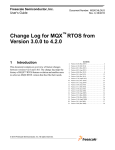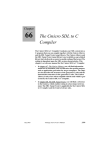Download Introduction cryptlib Overview
Transcript
Introduction The information age has seen the development of electronic pathways that carry vast amounts of valuable commercial, scientific, and educational information between financial institutions, companies, individuals, and government organisations. Unfortunately the unprecedented levels of access provided by systems like the Internet also expose this data to breaches of confidentiality, disruption of service, and outright theft. As a result, there is an enormous (and still growing) demand for the means to secure these online transactions. One report by the Computer Systems Policy Project (a consortium of virtually every large US computer company, including Apple, AT&T, Compaq, Digital, IBM, Silicon Graphics, Sun, and Unisys) estimated that the potential revenue arising from these security requirements in the US alone could be as much as US$30-60 billion in the next few years, and the potential exposure to global users from a lack of this security is projected to reach between US$320 and 640 billion. Unfortunately the security systems required to protect data are generally extremely difficult to design and implement, and even when available tend to require considerable understanding of the underlying principles in order to be used. This has lead to a proliferation of “snake oil” products that offer only illusionary security. Many organisations have held back from deploying online information systems because the means to secure them weren’t readily available, or because they previously attempted weak, easily broken security that was unacceptable to users. The cryptlib security toolkit provides the answer to this problem. A complete description of the capabilities provided by cryptlib is given below. cryptlib Overview cryptlib is a powerful security toolkit that allows even inexperienced crypto programmers to easily add encryption and authentication services to their software. The high-level interface provides anyone with the ability to add strong security capabilities to an application in as little as half an hour, without needing to know any of the low-level details that make the encryption or authentication work. Because of this, cryptlib dramatically reduces the cost involved in adding security to new or existing applications. At the highest level, cryptlib provides implementations of complete security services such as S/MIME and PGP/OpenPGP secure enveloping, SSL/TLS and SSH secure sessions, CA services such as CMP, SCEP, RTCS, and OCSP, and other security operations such as secure timestamping (TSP). Since cryptlib uses industry-standard X.509, S/MIME, PGP/OpenPGP, and SSH/SSL/TLS data formats, the resulting encrypted or signed data can be easily transported to other systems and processed there, and cryptlib itself runs on virtually any operating system — cryptlib doesn’t tie you to a single platform. This allows email, files, and EDI transactions to be authenticated with digital signatures and encrypted in an industry-standard format. cryptlib provides an extensive range of other capabilities including full X.509/PKIX certificate handling (all X.509 versions from X.509v1 to X.509v3) with additional support for SET, Microsoft AuthentiCode, Identrus, RPKI, SigG, S/MIME, SSL, and Qualified certificates, PKCS #7 certificate chains, handling of certification requests and CRLs including automated checking of certificates against CRLs and online checking using RTCS and OCSP, and issuing and revoking certificates using CMP and SCEP. In addition cryptlib implements a full range of certificate authority (CA) functions, as well as providing complete CMP, SCEP, RTCS, and OCSP server implementations to handle online certificate enrolment/issue/revocation and certificate status checking. Alongside the certificate handling, cryptlib provides a sophisticated key storage interface that allows the use of a wide range of key database types ranging from PKCS #11 devices, PKCS #15 key files, and PGP/OpenPGP key rings through to commercial-grade RDBMS’ and LDAP directories with optional SSL protection. In addition to its built-in capabilities, cryptlib can make use of the crypto capabilities of a variety of external crypto devices such as hardware crypto accelerators, Fortezza cards, PKCS #11 devices, hardware security modules (HSMs), and crypto smart cards. For particularly demanding applications cryptlib can be used with a variety of crypto devices that have received appropriate FIPS 140 or ITSEC/Common Criteria certification. The crypto device interface also provides a convenient general-purpose plug-in capability for adding new functionality that will be automatically used by cryptlib. cryptlib also provides a general-purpose crypto HAL (hardware abstraction layer) interface that allows it to use the native crypto capabilities available in some ARM, MIPS, and PPC cores used in embedded systems and devices. cryptlib is supplied as source code for AMX, BeOS, ChorusOS, DOS, DOS32, eCOS, µC/OS-II, embedded Linux, FreeRTOS/OpenRTOS, IBM MVS, µITRON, Macintosh/OS X, OS/2, PalmOS, RTEMS, Tandem, ThreadX, a variety of Unix versions (including AIX, Digital Unix, DGUX, FreeBSD/NetBSD/OpenBSD, HP-UX, IRIX, Linux, MP-RAS, OSF/1, QNX, SCO/UnixWare, Solaris, SunOS, Ultrix, and UTS4), uClinux, VM/CMS, VxWorks, Windows 3.x, Windows 95/98/ME, Windows CE/PocketPC/SmartPhone, Windows NT/2000/XP/Vista/Windows 7 (32and 64-bit versions), VDK, and Xilinx XMK. cryptlib’s highly portable nature means that it is also being used in a variety of custom embedded system environments. cryptlib comes with language bindings for C / C++, C# / .NET, Delphi, Java, Perl, Python, and Visual Basic (VB). cryptlib features cryptlib provides a standardised interface to a number of popular encryption algorithms, as well as providing a high-level interface that hides most of the implementation details and uses operating-systemindependent encoding methods that make it easy to transfer secured data from one operating environment to another. Although use of the highlevel interface is recommended, experienced programmers can directly access the lower-level encryption routines for implementing custom encryption protocols or methods not directly provided by cryptlib. Architecture cryptlib consists of a set of layered security services and associated programming interfaces that provide an integrated set of information and communications security capabilities. Much like the network reference model, cryptlib contains a series of layers that provide each level of abstraction, with higher layers building on the capabilities provided by the lower layers. At the lowest level are basic components such as core encryption and authentication routines, which are usually implemented in software but may also be implemented in hardware (due to the speed of the software components used in cryptlib, the software is usually faster than dedicated hardware). At the next level are components that wrap up the specialised and often quite complex core components in a layer that provides abstract functionality and ensures complete cross-platform portability of data. These functions typically cover areas such as “create a digital signature” or “exchange an encryption key”. At the highest level are extremely powerful and easy-to-use functions such as “encrypt a message”, “sign a message”, “open a secure link”, and “create a digital certificate” that require no knowledge of encryption techniques, and that take care of complex issues such as key management, data encoding, en/decryption, and digital signature processing. High-level interface Secure data enveloping Secure communications sessions Certificate management Security services interface Key exchange Digital signature Key generation Encryption services interface Native encryption services Adaptation layer Adaptation layer Third-party encryption services Third-party encryption services Key management Key store interface Native database services Adaptation layer Third-party database services cryptlib’s powerful object management interface provides the ability to add encryption and authentication capabilities to an application without needing to know all the low-level details that make the encryption or authentication work. The automatic object-management routines take care of encoding issues and cross-platform portability problems, so that a handful of function calls is all that’s needed to wrap up data in signed or encrypted form with all of the associated information and parameters needed to recreate it on the other side of a communications channel. This provides a considerable advantage over other encryption toolkits that often require hundreds of lines of code and the manipulation of complex encryption data structures to perform the same task. S/MIME cryptlib employs the IETF-standardised Cryptographic Message Syntax (CMS, formerly called PKCS #7) format as its native data format. CMS is the underlying format used in the S/MIME secure mail standard, as well as a number of other standards covering secure EDI and related systems like HL7 medical messaging and the Session Initiation Protocol (SIP) for services like Internet telephony and instant messaging. The S/MIME implementation uses cryptlib’s enveloping interface which allows simple, rapid integration of strong encryption and authentication capabilities into existing email agents and messaging software. The resulting signed enveloped data format provides message integrity and origin authentication services, the encrypted enveloped data format provides confidentiality, and the authenticated encrypted data format provides all of these services at once. In addition cryptlib’s S/MIME implementation allows external services such as trusted timestamping authorities (TSAs) to be used when a signed message is created, providing externally-certified proof of the time of message creation. The complexity of the S/MIME format means that the few other toolkits that are available require a high level of programmer knowledge of S/MIME processing issues. In contrast cryptlib’s enveloping interface makes the process as simple as pushing raw data into an envelope and popping the processed data back out, a total of three function calls, plus one more call to add the appropriate encryption or signature key. PGP/OpenPGP Alongside the PKCS #7/CMS/SMIME formats, cryptlib supports the PGP/OpenPGP message format, allowing it to be used to send and receive PGP-encrypted email and data. As with the S/MIME implementation, the PGP implementation uses cryptlib’s enveloping interface to allow simple, rapid integration of strong encryption and authentication capabilities into existing email agents and messaging software. Since the enveloping interface is universal, the process involved in creating PGP and S/MIME messages is identical except for the envelope format specifier, allowing a one-off development effort to handle any secure message format. SSH and SSL/TLS cryptlib supports secure network sessions using the SSH and SSL/TLS security protocols. As with envelopes, cryptlib takes care of the session details for you so that all you need to do is provide basic communications information such as the name of the server or host to connect to and any other information required for the session such as a password or certificate. cryptlib takes care of establishing the session and managing the details of the communications channel and its security parameters, and provides both client and server implementations of all of these session types. PKI Services: CMP, OCSP, RTCS, SCEP, TSP In addition to SSH and SSL/TLS, cryptlib also implements a full range of PKI services in its secure session interface, again providing both client and server implementations of all protocols. These services include the certificate management protocol (CMP), simple certificate enrolment protocol (SCEP), real-time certificate status protocol (RTCS), online certificate status protocol (OCSP), and timestamping (TSP). By tying a key or certificate store to the session, you can let cryptlib take care of any key management issues for you. With a CMP or SCEP server session cryptlib will use the certificate store to handle the certificate management process. In this way a complete CMP-based CA that handles enrolment, certificate update and renewal, and certificate revocation, can be implemented with only a handful of function calls. Plug-and-play PKI Working with certificates can be complex and painful, requiring the use of a number of arcane and difficult-to-use mechanisms to perform even the simplest operations. To eliminate this problem cryptlib provides a plugand-play PKI interface that manages all certificate processing and management operations for you, requiring no special knowledge of certificate formats, protocols, or operations. Using the plug-and-play PKI interface with an appropriately-configured CA means that cryptlib will automatically and transparently handle key generation, certificate enrolment, securely obtaining trusted CA certificates, and certifying the newly-generated keys for the user, all in a single operation. Similarly, certificate validity checking can be performed using an online real-time status check that avoids the complexity and delayed status information provided by mechanisms like CRLs. The plug-and-play PKI interface removes most of the complexity and difficulty involved in working with certificates, making it easier to use certificates than with any of the conventional certificate management mechanisms. Certificate Management cryptlib implements full X.509 certificate support, including all X.509 version 3 extensions as well as extensions defined in the IETF PKIX certificate profile. cryptlib also supports additional certificate types and extensions including SET certificates, Microsoft AuthentiCode and Netscape and Microsoft server-gated crypto certificates, Identrus certificates, qualified certificates, resource PKI (RPKI) certificates, S/MIME and SSL client and server certificates, SigG extensions, and various vendor-specific extensions such as Netscape certificate types and the Thawte secure extranet. In addition to certificate handling, cryptlib allows the generation of certification requests suitable for submission to certification authorities (CAs) in order to obtain a certificate. Since cryptlib is itself capable of processing certification requests into certificates, it is also possible to use cryptlib to provide full CA services. cryptlib also supports creating and handling of certificate chains required for S/MIME, SSL/TLS, and other applications, and the creation of certificate revocation lists (CRLs) with the capability to check certificates against existing or new CRLs either automatically or under programmer control. In addition to CRL-based revocation checking, cryptlib also supports online status protocols such as RTCS and OCSP. cryptlib also implements the CMP protocol which fully automates the management of certificates, allowing online certificate enrolment, issue, update/replacement, and revocation of certificates, and the SCEP protocol, which automates the certificate issue process. Using CMP removes from the user any need for technical knowledge of certificate management, since all details are managed by the CA. cryptlib can import and export certification requests, certificates, certificate chains, and CRLs, covering the majority of certificate transport formats used by a wide variety of software such as web browsers and servers. The certificate types that are supported include: • Basic X.509 version 1 and 2 certificates • Extended X.509 version 3 certificates • AuthentiCode code signing certificates • Certificates conformant to the IETF PKIX profile • Identrus certificates • IPsec server, client, end-user, and tunnelling certificates • Qualified certificates • Resource PKI (RPKI) certificates • Server-gated crypto certificates • SET certificates • SigG certificate extensions • S/MIME email certificates • SSL/TLS server and client certificates • Timestamping certificates In addition cryptlib supports X.509v3 IETF, S/MIME, SET, and SigG certificate extensions and many vendor-specific extensions including ones covering public and private key usage, certificate policies, path and name constraints, policy constraints and mappings, and alternative names and other identifiers. This comprehensive coverage makes cryptlib a single solution for almost all certificate processing requirements. The diagram below shows a typical cryptlib application, in which it provides the full functionality of both a CA (processing certification requests, storing the issued certificates locally in a certificate database, and optionally publishing the certificates on the web or in an LDAP directory) and an end entity (generating certification requests, submitting them to a CA, and retrieving the result from the web or a directory service). To handle certificate trust and revocation issues, cryptlib includes a certificate trust manager that can be used to automatically manage CA trust settings. For example a CA can be designated as a trusted issuer that will allow cryptlib to automatically evaluate trust along certificate chains. Similarly, cryptlib can automatically check certificates against RTCS and OCSP responders and CRLs published by CAs, removing from the user the need to perform complex manual checking. CA Operations cryptlib includes a scalable, flexible Certificate Authority (CA) engine built on the transaction-processing capabilities of a number of proven, industrial-strength relational databases running on a variety of hardware platforms. The CA facility provides an automated means of handling certificate issuance without dealing directly with the details of processing request, signing certificates, saving the resulting certificates in keys stores, and assembling CRLs. This constitutes a complete CA system for issuance and management of certificates and CRLs. A typical cryptlib CA configuration is shown below. Available CA operations include: • Certificate enrolment/initialisation operations • Certificate issue • Certificate update/key update • Certificate expiry management • Revocation request processing • CRL issue All CA operations are recorded to an event log using cryptlib’s built-in CA logging/auditing facility, which provides a comprehensive audit facility via a full account of certificate requests, certificates issued or renewed, revocations requested and issued, certificates expired, and general CA management operations. The logs can be queried for information on all events or a specified subset of events, for example all certificates that were issued on a certain day. cryptlib contains a full implementation of a CMP server (to handle online certificate management), and SCEP server (to handle online certificate issue), a RTCS server (to handle real-time certificate status checking), and an OCSP server (to handle revocation checking). All of these servers are fully automated, requiring little user intervention beyond the initial enrolment process in which user eligibility for a certificate is established. These services make it easier than ever to manage your own CA. Certificate expiration and revocation are handled automatically by the CA engine. Expired certificates are removed from the certificate store, and CRLs are assembled from previously processed certificate revocation requests. These operations are handled with a single function call, for example issuing a CRL is done with: cryptCACertManagement( &cryptCRL, CRYPT_CERTACTION_ISSUE_CRL, cryptCertStore, CRYPT_UNUSED ); The CA keys can optionally be generated and held in tamper-resistant hardware security modules, with certificate signing being performed by the hardware module. Issued certificates can be stored on smart cards or similar crypto devices in addition to being managed using software-only implementations. The CA facility supports the simultaneous operation of multiple CAs, for example to manage users served through divisional CAs certified by a root CA. Each CA can issue multiple certificates to users, allowing the use of separate keys bound to signature and encryption certificates. Crypto Devices, Hardware, and Smart Card Support In addition to its built-in capabilities, cryptlib can make use of the crypto capabilities of external crypto devices and on-chip encryption accelerators, crypto cores, and other hardware. External device types supported include: • Crypto smart cards • Dallas iButtons • Datakeys/iKeys • Fortezza cards • Hardware crypto accelerators • Hardware security modules (HSMs) • PCMCIA crypto tokens • PCI crypto cards • PKCS #11 devices • USB tokens Both these external devices and on-chip encryption hardware present in some embedded processors and devices can be used by cryptlib to handle functions such as key generation and storage, certificate creation, digital signatures, and message en- and decryption. Typical applications include: • Running a certification authority inside tamper-resistant hardware • Smart-card based digital signatures • Message encryption/decryption in secure hardware cryptlib manages any device-specific interfacing requirements so that the programming interface for any crypto device is identical to cryptlib’s native interface, allowing existing applications that use cryptlib to be easily and transparently migrated to using crypto devices. The ability to mix and match crypto devices and the software-only implementation allows appropriate tradeoffs to be chosen between flexibility, cost, and security. Certificate Store Interface cryptlib utilizes commercial-strength RDBMS’ to store keys in the internationally standardised X.509 format. The certificate store integrates seamlessly into existing databases and can be managed using existing tools. For example a key database stored on an MS SQL Server might be managed using Visual Basic or MS Access; a key database stored on an Oracle server might be managed through SQL*Plus. In addition to standard certificate stores, cryptlib supports the storage and retrieval of certificates in LDAP directories, HTTP access for keys accessible via the web, and external flat-file key collections such as PKCS #15 soft-tokens and PGP/OpenPGP key rings. The key collections can be freely mixed (so for example a private key could be stored in a PKCS #15 soft-token, a PGP/OpenPGP key ring or on a smart card with the corresponding X.509 certificate being stored in a certificate store, an LDAP directory, or on the web). Private keys can be stored on disk encrypted with an algorithm such as triple DES or AES (selectable by the user), with the password processed using several thousand iterations of a hashing algorithm like SHA-1 or SHA-256 (also selectable by the user) and the key data protected from tampering with an algorithm like HMAC-SHA1 or HMAC-SHA256 (again selectable by the user). Where the operating system supports it, cryptlib will apply system security features such as ACLs under Windows NT/2000/XP/Vista/Windows 7 and file permissions under Unix to the private key file to further restrict access. User Interface In addition to its general security functionality, cryptlib includes a number of user interface components that simplify the task of working with keys and certificates. Components such as the certificate viewer shown below allow users to browse the contents of certificates, certificate chains, requests, and other certificate objects. The key generation wizard simplifies the task of key and certificate generation by handling most of the details of the process automatically, producing a complete public/private key pair and certificate request suitable for submission to a CA, or a self-signed certificate for immediate use. These user interface components remove much of the complexity of the key and certificate management process, allowing developers to concentrate on applying the completed keys and certificates towards securing data, email, or communications sessions rather than on the process needed to create them. Security Features cryptlib is built around a security kernel with Orange Book B3-level security features to implement its security mechanisms. This kernel provides the interface between the outside world and the architecture’s objects (intra-object security) and between the objects themselves (inter- object security). The security kernel is the basis of the entire cryptlib architecture — all objects are accessed and controlled through it, and all object attributes are manipulated through it. The kernel is implemented as an interface layer that sits on top of the objects, monitoring all accesses and handling all protection functions. Each cryptlib object is contained entirely within the security perimeter, so that data and control information can only flow in and out in a very tightly-controlled manner, and objects are isolated from each other within the perimeter by the security kernel. For example once keying information has been sent to an object, it can’t be retrieved by the user except under tightly-controlled conditions. In general keying information isn’t even visible to the user, since it’s generated inside the object itself and never leaves the security perimeter. This design is ideally matched to hardware implementations that perform strict red/black separation, since sensitive information can never leave the hardware. Associated with each object is a set of mandatory ACLs that determine who can access a particular object and under which conditions the access is allowed. If the operating system supports it, all sensitive information used will be page-locked to ensure that it’s never swapped to disk from where it could be recovered using a disk editor. All memory corresponding to security-related data is managed by cryptlib and will be automatically sanitised and freed when cryptlib shuts down even if the calling program forgets to release the memory itself. Where the operating system supports it, cryptlib will apply operating system security features to any objects that it creates or manages. For example under Windows NT/2000/XP/Vista/Windows 7 cryptlib private key files will be created with an access control list (ACL) that allows only the key owner access to the file; under Unix the file permissions will be set to achieve the same result. Embedded Systems cryptlib’s high level of portability and configurability makes it ideal for use in embedded systems with limited resources or specialised requirements, including ones based on Altera NIOS, ARM7, ARM9, ARM TDMI, Coldfire, Fujitsu FR-V, Hitachi SuperH, MIPS IV, MIPS V, Motorola ColdFire, NEC V8xx series, NEC VRxxxx series, Panasonic/ Matsushita AM33/AM34, PowerPC, PowerQUICC, Samsung CalmRISC, SH3, SH4, SPARC, SPARClite, StrongArm, TI OMAP, and Xilinx MicroBlaze processors, as well as a large range of licensed derivatives of these cores, too many and varied to enumerate here. cryptlib doesn’t perform any floating-point operations and runs directly on processors without an FPU, and through its crypto HAL (hardware abstraction layer) capabilities can take advantage of on-chip or in-system cryptographic hardware capabilities and crypto cores where available, typically on some of the more advanced ARM, MIPS, and PPC cores. The code is fully independent of any underlying storage or I/O mechanisms, and works just as easily with abstractions like named memory segments in flash memory as it does with standard key files on disk. It has been deployed on embedded systems without any conventional I/O capabilities (stdio) or dynamic memory allocation facilities, with proprietary operating system architectures and services including ATMs, printers, web-enabled devices, POS systems, embedded device controllers, and similar environments, and even in devices with no operating system at all (cryptlib runs on the bare metal). It can also run independent of any form of operating system, and has been run on the bare metal in environments with minimal available resources, in effect functioning as a complete crypto operating system for the underlying hardware. Because cryptlib functions identically across all supported environments, it’s possible to perform application development in a full-featured development environment such as Windows or Unix and only when the application is complete and tested move it to the embedded system. This flexibility saves countless hours of development time, greatly reducing the amount of time that needs to be spent with embedded systems debuggers or in-circuit emulators since most of the development and code testing can be done on the host system of choice. If required the cryptlib developers can provide assistance in moving the code to any new or unusual environments. Performance cryptlib is re-entrant and completely thread-safe, allowing it to be used with multithreaded applications under operating systems that support threads. Because it is thread-safe, lengthy cryptlib operations can be run in the background if required while other processing is performed in the foreground. In addition cryptlib itself is multithreaded so that computationally intensive internal operations take place in the background without impacting the performance of the calling application. Many of the core algorithms used in cryptlib have been implemented in assembly language in order to provide the maximum possible performance, and will take advantage of crypto hardware acceleration facilities present in some CPUs such as the Via CPU family. These routines provide an unprecedented level of performance, in most cases running faster than expensive, specialised encryption hardware designed to perform the same task. This means that cryptlib can be used for highbandwidth applications such as video/audio encryption and online network and disk encryption without the need to resort to expensive, specialised encryption hardware. Programming Interface cryptlib’s easy-to-use high-level routines allow for the exchange of encrypted or signed messages or the establishment of secure communications channels with a minimum of programming overhead. Language bindings are available for C / C++, C# / .NET, Delphi, Java, Perl, Python and Visual Basic (VB). cryptlib has been written to be as foolproof as possible. On initialisation it performs extensive self-testing against test data from encryption standards documents, and the APIs check each parameter and function call for errors before any actions are performed, with error reporting down to the level of individual parameters. In addition logical errors such as, for example, a key exchange function being called in the wrong sequence, are checked for and identified. Documentation cryptlib comes with extensive documentation in the form of a 350-page user manual and a 320-page technical reference manual. The user manual is intended for everyday cryptlib use and contains detailed documentation on every aspect of cryptlib’s functionality. In most cases the code needed to secure an application can be cut and pasted directly from the appropriate section of the manual, avoiding the need to learn yet another programming API. The technical reference manual covers the design and internals of cryptlib itself, including the cryptlib security model and security mechanisms that protect every part of cryptlib’s operation. In addition the technical manual provides a wealth of background information to help users understand the security foundations on which cryptlib is built. Algorithm Support Included as core cryptlib components are implementations of the most popular encryption and authentication algorithms, AES, Blowfish, CAST, DES, triple DES, IDEA, RC2, RC4, RC5, and Skipjack conventional encryption, MD2, MD4, MD5, RIPEMD-160, SHA-1, and SHA-2/SHA256 hash algorithms, HMAC-MD5, HMAC-SHA1, HMAC-RIPEMD-160, and HMAC-SHA2 MAC algorithms, and Diffie-Hellman, DSA, ECDSA, ECDH, Elgamal, and RSA public-key encryption algorithms. The algorithm parameters are summarised below: Algorithm AES Blowfish Key size 128/192/256 448 Block size 128 64 Algorithm CAST-128 DES Triple DES IDEA RC2 RC4 RC5 Skipjack MD2 MD4 MD5 RIPEMD-160 SHA-1 SHA-2 / SHA-256 HMAC-MD5 HMAC-SHA1 HMAC-SHA2 HMAC-RIPEMD160 Diffie-Hellman DSA ECDSA ECDH Elgamal RSA Key size 128 56 112 / 168 128 1024 2048 832 80 — — — — — — 128 160 256 160 Block size 64 64 64 64 64 8 64 64 128 128 128 160 160 256 128 160 256 160 4096 40961 521 521 4096 4096 — — — — — — Standards Compliance All algorithms, security methods, and data encoding systems in cryptlib either comply with one or more national and international banking and security standards or are implemented and tested to conform to a reference implementation of a particular algorithm or security system. Compliance with national and international security standards is automatically provided when cryptlib is integrated into an application. These standards include ANSI X3.92, ANSI X3.106, ANSI X9.9, ANSI X9.17, ANSI X9.30-1, ANSI X9.30-2, ANSI X9.31-1, ANSI X9.42, ANSI X9.52, ANSI X9.55, ANSI X9.57, ANSI X9.62, ANSI X9.63, ANSI X9.73, ETSI TS 101 733, ETSI TS 101 861, ETSI TS 101 862, ETSI TS 102, FIPS PUB 46-2, FIPS PUB 46-3, FIPS PUB 74, FIPS PUB 81, FIPS PUB 113, FIPS PUB 180, FIPS PUB 180-1, FIPS PUB 186, FIPS PUB 198, ISO/IEC 8372, ISO/IEC 8731 ISO/IEC 8732, ISO/IEC 8824/ITU-T X.680, 1 The DSA standard only defines key sizes from 512 to 1024 bits, cryptlib supports longer keys but there is no extra security to be gained from using these keys. ISO/IEC 8825/ITU-T X.690, ISO/IEC 9797, ISO/IEC 10116, ISO/IEC 10118, ISO/IEC 15782, ITU-T X.842, ITU-T X.843, PKCS #1, PKCS #3, PKCS #5, PKCS #7, PKCS #9, PKCS #10, PKCS #11, PKCS #15, RFC 1319, RFC 1320, RFC 1321, RFC 1750, RFC 1991, RFC 2040, RFC 2104, RFC 2144, RFC 2202, RFC 2246, RFC 2268, RFC 2311 (cryptographyrelated portions), RFC 2312, RFC 2313, RFC 2314, RFC 2315, RFC 2437, RFC 2440, RFC 2459, RFC 2510, RFC 2511, RFC 2528, RFC 2560, RFC 2585, RFC 2630, RFC 2631, RFC 2632, RFC 2633 (cryptography-related portions), RFC 2634, RFC 2785, RFC 2876, RFC 2898, RFC 2984, RFC 2985, RFC 2986, RFC 3039, RFC 3058, RFC 3114, RFC 3126, RFC 3161, RFC 3174, RFC 3183, RFC 3211, RFC 3218, RFC 3261 (cryptographyrelated portions), RFC 3268, RFC 3274, RFC 3279, RFC 3280, RFC 3281, RFC 3369, RFC 3370, RFC 3447, RFC 3546, RFC 3565, RFC 3739, RFC 3770, RFC 3779, RFC 3851, RFC 3852, RFC 4055, RFC 4086, RFC 4108, RFC 4134, RFC 4210, RFC 4211, RFC 4231, RFC 4250, RFC 4251, RFC 4252, RFC 4253, RFC 4254, RFC 4256, RFC 4262, RFC 4279, RFC 4325, RFC 4334, RFC 4346, RFC 4366, RFC 4387, RFC 4419, RFC 4476, RFC 4648, RFC 4680, RFC 4681, and the Payment Card Industry (PCI) Data Security Standard (cryptography-related portions). In addition cryptlib can be used as an add-on security module to provide security services as per ISO/IEC 62351 for SCADA protocols such as IEC 60870-5, DNP 3.0, IEC 60870-6 (TASE.2 or ICCP), IEC 61850, and IEC 61334 (DLMS). Because of the use of internationally recognised and standardised security algorithms, cryptlib users will avoid the problems caused by home-grown, proprietary algorithms and security techniques that often fail to provide any protection against attackers, resulting in embarrassing bad publicity and expensive product recalls. Configuration Options cryptlib works with a configuration database that can be used to tune its operation for different environments. This allows a system administrator to set a consistent security policy which is then automatically applied by cryptlib to operations such as key generation and data encryption and signing, although they can be overridden on a per-application or per-user basis if required. cryptlib Applications The security services provided by cryptlib can be used in virtually any situation that requires the protection or authentication of sensitive data. Some areas in which cryptlib is currently used include: • Protection of medical records transmitted over electronic links. • Protection of financial information transmitted between branches of banks. • Transparent disk encryption. • Strong security services added to web browsers with weak, exportable security. • Running a CA. • Encrypted electronic mail. • File encryption. • Protecting content on Internet servers. • Digitally signed electronic forms. • S/MIME mail gateway. • Secure database access. • Protection of credit card information. Encryption Code Example The best way to illustrate what cryptlib can do is with an example. The following code encrypts a message using public-key encryption. /* Create an envelope for the message */ cryptCreateEnvelope( &cryptEnvelope, cryptUser, CRYPT_FORMAT_SMIME ); /* Push in the message recipient's name */ cryptSetAttributeString( cryptEnvelope, CRYPT_ENVINFO_RECIPIENT, recipientName, recipientNameLength ); /* Push in the message data and pop out the encrypted result */ cryptPushData( cryptEnvelope, message, messageSize, &bytesIn ); cryptFlushData( cryptEnvelope ); cryptPopData( cryptEnvelope, encryptedMessage, encryptedSize, &bytesOut ); /* Clean up */ cryptDestroyEnvelope( cryptEnvelope ); This performs the same task as a program like PGP using just 6 function calls (to create a PGP/OpenPGP message, just change the CRYPT_FORMAT_SMIME to CRYPT_FORMAT_PGP). All data management is handled automatically by cryptlib, so there’s no need to worry about encryption modes and algorithms and key lengths and key types and initialisation vectors and other details (although cryptlib provides the ability to specify all this if you feel the need). This is all that’s required — just copy the above code into your application to S/MIME-enable it. The code shown above results in cryptlib performing the following actions: • Generate a random session key for the default encryption algorithm (usually triple DES or AES). • Look up the recipient’s public key in a key database. • Encrypt the session key using the recipient’s public key. • Encrypt the signed data with the session key. • Pass the result back to the user. However unless you want to call cryptlib using the low-level interface, you never need to know about any of this. cryptlib will automatically know what to do with the data based on the resources you add to the envelope — if you add a signature key it will sign the data, if you add an encryption key it will encrypt the data, and so on. Secure Session Code Example Establishing a secure session using SSL/TLS is similarly easy: CRYPT_SESSION cryptSession; /* Create the session */ cryptCreateSession( &cryptSession, cryptUser, CRYPT_SESSION_SSL ); /* Add the server name and activate the session */ cryptSetAttributeString( cryptSession, CRYPT_SESSINFO_SERVER_NAME, serverName, serverNameLength ); cryptSetAttribute( cryptSession, CRYPT_SESSINFO_ACTIVE, 1 ); If you prefer SSH to SSL, just change the CRYPT_SESSION_SSL to CRYPT_SESSION_SSH and add a user name and password to log on. As with the encryption code example above, cryptlib provides a single unified interface to its secure session mechanisms, so you don’t have to invest a lot of effort in adding special-case handling for different security protocols and mechanisms. The corresponding SSL/TLS (or SSH if you prefer) server is: CRYPT_SESSION cryptSession; /* Create the session */ cryptCreateSession( &cryptSession, cryptUser, CRYPT_SESSION_SSL_SERVER ); /* Add the server key/certificate and activate the session */ cryptSetAttribute( cryptSession, CRYPT_SESSINFO_PRIVATEKEY, privateKey ); cryptSetAttribute( cryptSession, CRYPT_SESSINFO_ACTIVE, 1 ); As with the secure enveloping example, cryptlib is performing a large amount of work in the background, but again there’s no need to know about this since it’s all taken care of automatically. Certificate Management Code Example The following code illustrates cryptlib’s plug-and-play PKI interface: CRYPT_SESSION cryptSession; /* Create the CMP session and add the server name/address */ cryptCreateSession( &cryptSession, cryptUser, CRYPT_SESSION_CMP ); cryptSetAttributeString( cryptSession, CRYPT_SESSINFO_SERVER, server, serverLength ); /* Add the username, password, and smart card */ cryptSetAttributeString( cryptSession, CRYPT_SESSINFO_USERNAME, userName, userNameLength ); cryptSetAttributeString( cryptSession, CRYPT_SESSINFO_PASSWORD, password, passwordLength ); cryptSetAttribute( cryptSession, CRYPT_SESSINFO_CMP_PRIVKEYSET, cryptDevice ); /* Activate the session */ cryptSetAttribute( cryptSession, CRYPT_SESSINFO_ACTIVE, TRUE ); This code takes a smart card and generates separate encryption and signing keys in it, requests a signature certificate from the CA for the signing key, uses that to obtain a certificate for the encryption key, obtains any further certificates that may be needed from the CA (for example for S/MIME signing or SSL server operation), and stores everything in the smart card. Compare this to the hundreds or even thousands of lines of code required to do the same thing using other toolkits. Oh yes, and cryptlib provides the CA-side functionality as well — there’s no need to pay an expensive commercial CA for your certificates, since cryptlib can perform the same function. Licensing and Pricing cryptlib is distributed under a dual license that allows free, open-source use under a GPL-like license (aka the "Sleepycat" license) and closedsource use under a standard commercial license. In addition, cryptlib is often free for use in low-cost, non-open-source applications such as shareware, and for personal and research use. NB: All cryptlib users must have a valid software license. Please contact the cryptlib sales team for further details, and a license estimate. Contact Sales and Licensing Shayne Jones Digital Data Security Limited 24 Durness Place, Orewa Auckland 0932, New Zealand Mailto:[email protected] Ph: +649 411 7297 Fax: +649 837 5817 Technical Support Mailto:[email protected] Visit www.cryptlib.com for more information. All intellectual property, trademarks and copyrights are the property of Digital Data Security Limited. © June 2010. All rights reserved.





















